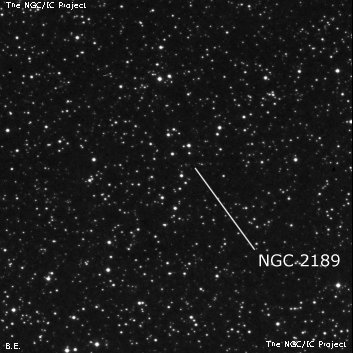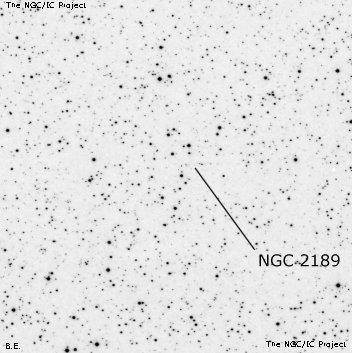NGC/IC Project Restoration Effort
(This is a very very beta version)
NGC2189


Basic Information
Location and Magnitude
Right Ascension: 6:12:17.0
Declination: +1:3:42
Constellation: ORI
Visual Magnitude:
Historic Information
Discoverer: Safford
Year of discovery: 1863
Discovery aperture: 15.0
Observational
Summary description: 2 clusters nr 2 st 9·10 ___DREYER___ 10·11
Sub-type: NF
Corwin's Notes
=====
NGC 2189 is described by T.H. Safford (not "J H Safford"; this is the same
T.H. Safford whose list of new nebulae formed an Appendix to the NGC) as "Two
clusters, seen 1863 March 19 near two stars of the 10-11th magnitude" with the
"Great Refractor" at Harvard College Observatory. (The NGC description
confuses the stars with two others in Safford's description of another cluster
NGC 2198, which see). Curiously, he gives positions of the two stars, but not
of the clusters (the NGC position was concocted by Dreyer). So, we can
identify the stars with certainty (Safford's positions, precessed to J2000.0,
are 06 11 50, +01 06.9 and 06 12 52, +01 08.2), but not the clusters -- there
is nothing in the area aside from random clumpings of field stars.
When I went over the field earlier, I finished up this note as follows:
However, two of the clumpings -- listed in the main table as possibly being
the correct objects -- may be the one's Safford noted. Both are extended
roughly north-south, with the first having a diameter of about 6 x 3 arcmin
and including only a dozen stars, and the second 3 x 2 arcmin, again with
only a dozen stars, fainter than those in the first group. Neither is
likely to be a real cluster.
Are these the right objects? We need visual observations, and a look at
Safford's original observing records, to be sure.
Looking again at the field in January 2014, I no longer think that the second
of the random groupings mentioned above (at 06 12 18, +01 03.7; J2000) can be
mistaken for a cluster. Instead, I am fingering another elongated (11 x 4
arcmin) clump of stars on to the east. The stars are brighter and closer to
the second of Safford's stars. However, I am no more confident of this clump
than I was of the fainter, smaller one.
Thinking of uncertainties, the second of Safford's stars may itself not be the
one I have suggested. There is another star at 06 12 53.0, +01 07 37 (2000)
that may be the one he measured. I've taken the one I did because the
declination is closer to Safford's reported number. Bond's paper mentions
that the stars are in the Harvard Zones, so the correct stars could be dug
out. Experience with other objects in Bond's AN list (NGC 5632, NGC 5651, and
NGC 5658; all of which see) suggests that the objects will be mentioned in the
"Remarks" column of the Harvard Zones in much the same way as they are in the
AN paper. We should nevertheless dig them out sometime.



